When the first diamond frame bicycles became popular in the 1890s they were often called "wheels" - the national cycling association was called the "League of American Wheelmen." We have moved from "wheels" to "bikes," but the bicycles have remained remarkably the same over more than 100 years - elegant in their efficiency and simplicity. And many of the issues that we think are new? They were around then too.
Showing posts with label Arlington. Show all posts
Showing posts with label Arlington. Show all posts
Tuesday, January 6, 2015
Arlington County Plows Bike Trails Early
Arlington Country bike trail along Four Mile Run - plowed at 6:45 am
The DC streets I saw, however, were not plowed at all. Crazy.
Monday, January 5, 2015
Arlington County Pre-Treats Bike Trails
Tomorrow we may have and inch or two of snow, starting around 4-5 am. Maybe.
There had been discussion of more allocation of resources to clear snow from "mixed use" (that is, bike) trails, but I had not realized this could include pre-treatment before the snow. On my way home today, turning off the Mount Vernon Trail onto the trail along Four Mile Run, I noticed the tell-tale lines on the pavement indicating some kind of vehicle had come through and applied some kind of treatment in advance of the snow's arrival.
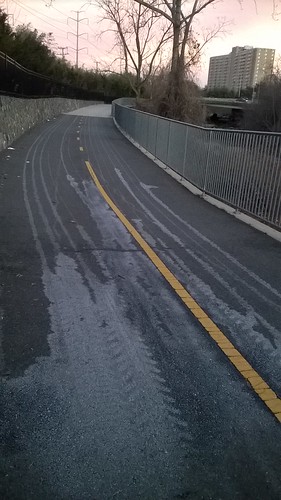
Looking away from Shirlington, you can see the application of some sort of liquid treatement both coming and going
Apparently this is where the vehicle turned around since a fair amount was spilled.
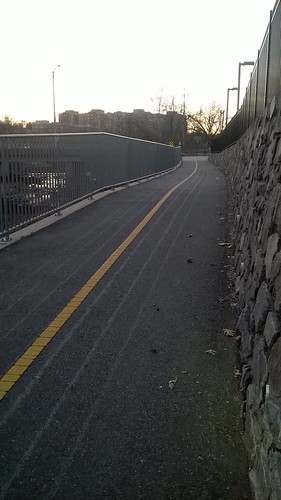
Looking towards Shirlington, you can see that the narrower trail means just one direction of application
I have no idea how helpful this will be. Find out tomorrow, most likely.
There had been discussion of more allocation of resources to clear snow from "mixed use" (that is, bike) trails, but I had not realized this could include pre-treatment before the snow. On my way home today, turning off the Mount Vernon Trail onto the trail along Four Mile Run, I noticed the tell-tale lines on the pavement indicating some kind of vehicle had come through and applied some kind of treatment in advance of the snow's arrival.

Looking away from Shirlington, you can see the application of some sort of liquid treatement both coming and going
Apparently this is where the vehicle turned around since a fair amount was spilled.

Looking towards Shirlington, you can see that the narrower trail means just one direction of application
I have no idea how helpful this will be. Find out tomorrow, most likely.
Wednesday, July 2, 2014
Four Mile Run Detour Re-Opens
This past Monday the detour for the Four Mile Run trail near the south end of National Airport was removed. The section of the trail that was under the bridge that was removed (see above) was widened somewhat and is edged on the inner side with some raised concrete. Work was being completed yesterday but the fences that enforced the detour were completely removed, so I am fairly sure it is OK to say the detour is done. It was open again this morning on the way to work.
The photo above shows the trail east of where the detour started - you can see that the bushes have taken over some of the trail while the work has been going on. Presumably Alexandria (I think this part of the trail is theirs) will send someone along to trim things up.
I was stopped to take this photo and blocking about 1/3 of the trail. The fellow in the photo came upon me and said, "excuse me" in a cranky tone which I took to be his way of complaining that I was blocking his speedy transit of this area. I don't know why people don't communicate more directly. What he clearly meant was, "you are in my f---ing way." Oh well. Mostly other cyclists seemed extremely pleased that the detour was over. I agree.
Sunday, March 23, 2014
Arlington County (VA) and Trail Plowing
March 9 I sent the following as an email to the Arlington Bike Coordinator; later I submitted a revised version to the County Board on their website.

Plowed trail near my house - makes a big difference!
This kind of systematic effort to clear trails used by cyclists (and others, of course) following snow storms is new this year in Arlington, and there was enough snowy weather for some experimentation. The first round was to use salt/road treatment type applications on the trails, which isn't great if you want to walk a dog using the trail and also is hard on the bicycle and the surrounding environment since the salt/chemicals aren't confined to the trail (asphalt). Plowing is a lot better, and the County shifted to that, which is great.
Better still would be to have a little less snow.
It appears that over the winter the County decided to switch from salting trails to plowing. (I leave near Rt 7 and Walter Reed and ride down the trail along Walter Reed, then down the trail along Four Mile Run to the Mt Vernon trail and then in to DC that way.)
I am surprised by the timeliness of some of the plowing that happened - in particular, the that runs parallel to Walter Reed between Rt 7 and Arlington Mill Drive was plowed recently very quickly after the snow - this makes a lot of sense since if you are going to plow trails (and not salt), it should happen fast before the snow turns into ice from people walking on it.
The different this past week was very noticeable between the trails I use in Arlington and the Mt Vernon Trail, which was untreated and unplowed. The main thing was that the trails that were plowed become clear and useable by a regular bike quickly and the Mt Vernon trail was only rideable until Thursday either by riding very carefully or by having a bike with studded tires (which I have).
Plowing isn't a perfect solution - Tuesday in particular some trails had been plowed before my morning ride but the result was that the asphalt (with the 15 degree weather) was coated with a thin sheet of ice instead of a thicker layer of ice and snow so that a regular bike would not have traction - it would have been impossible to ride without studded tires. But by that afternoon the situation was already better, and Wednesday morning the Arlington trails were rideable (with care) while the Mt Vernon trail was not. Still, I think plowing is better than treating with salt etc.
The plowing is good. Thank you.

Plowed trail near my house - makes a big difference!
This kind of systematic effort to clear trails used by cyclists (and others, of course) following snow storms is new this year in Arlington, and there was enough snowy weather for some experimentation. The first round was to use salt/road treatment type applications on the trails, which isn't great if you want to walk a dog using the trail and also is hard on the bicycle and the surrounding environment since the salt/chemicals aren't confined to the trail (asphalt). Plowing is a lot better, and the County shifted to that, which is great.
Better still would be to have a little less snow.
Friday, January 24, 2014
Limits of Cold Weather Commuting
As in, my limits. Well, my limits and the limits of my cycling equipment.
My ice commuter, for better or worse
Today was the second day I rode back and forth the ten miles between my house and Capitol Hill with the trails pretty icy and in reasonably cold weather, particularly in the morning. In my years of commuting in more or less all weather, it is fairly unusual to have sustained cold such that the trail conditions didn't change that much between two days. In a few places some salt had cleared areas, but it was not like the second day was a huge improvement. (Mostly the trails are not treated.)
This morning it was cold, for here at least, at around 12-14 F - around -10 C. It was colder than yesterday and since it took me over an hour to get to work, my fingers were starting to get cold on one hand - but overall my cold weather biking clothes work OK at least down to this temp. But I need to keep moving, spinning, to maintain my warmth.
The bigger problem is with my bike and my fitness (my "fitness" in the broader sense of being physically ready for such an endeavor). The bike is an old Giant that I have only ridden in the last few years when I want to take advantage of the studded tires I have mounted on it, and that's it. The bike could use some adjustments. The rear brakes in particular don't work well in these conditions and of course when it is slick the front brake can't be used (much) without instantly causing a crash so the poor rear brake performance isn't helpful at all. (I should fix that!) The 1.95 inch wide tires with the studs are lovely for traction when the surface is mostly flat/smooth but if there is accumulated snow or snow+ice they have a terrific amount of road (or I guess snow) resistance - the width isn't helpful.
But it does work. Two days running I rode back and forth on a lot of slick surfaces and didn't fall once. And I got back and forth.
The Gravelly Point area of the Mount Vernon Trail; another riding north as I head south
I don't see too many other riders on the trail on a day like this. Today I saw two riders coming the other way on my ride home (total) - one was a commuter and the other fellow just seemed to be out enjoying the fun to be had. The photo above shows the commuter I saw, chugging along. He did not, I think, have studded tires - he was riding a cyclocross sort of 700 size tire bike and was hugging the right edge of the trail. I am familiar with this approach - basically you stay away from where other riders have been riding and especially stay away from icy sections. The narrow tires cut through the snow OK and you have traction but it very tiring to maintain this kind of straight-ish line.
My approach with the wide mountain bike tires is to stick to the middle where the snow is pounded flat and where there is compacted snow on ice and try to skirt as much of the clear ice as I can. The studded tires will allow some riding on clear ice, but you can't brake or steer (much). And sometimes you hit a bump and the bike simple slides. The studs aren't a perfect solution.
It's an adventure (or something like one, for me) but I'm glad to have the weekend now to rest up. I don't know if I could do more than two days running of this. I was unhappy this morning to pass a guy walking his bike on the Mount Vernon Trail near the airport, on one of the bridges - he had a very nice bike, but apparently was having no luck staying upright. He didn't look like he was dressed as warmly as me, and walking . . . I didn't have anything to help him with this problem, so I just kept going.
A snow-bike patent for a set of attachments from 1900 - but my problem was ice, alas
I have a sort of cyclocross bike that is presently out of commission with disk brakes - I should get some studded tires for that thing when they are on sale so I have a bike to ride in this kind of weather with working brakes and have narrower tires to cut through snow. For next year. Yeah.
My ice commuter, for better or worse
Today was the second day I rode back and forth the ten miles between my house and Capitol Hill with the trails pretty icy and in reasonably cold weather, particularly in the morning. In my years of commuting in more or less all weather, it is fairly unusual to have sustained cold such that the trail conditions didn't change that much between two days. In a few places some salt had cleared areas, but it was not like the second day was a huge improvement. (Mostly the trails are not treated.)
This morning it was cold, for here at least, at around 12-14 F - around -10 C. It was colder than yesterday and since it took me over an hour to get to work, my fingers were starting to get cold on one hand - but overall my cold weather biking clothes work OK at least down to this temp. But I need to keep moving, spinning, to maintain my warmth.
The bigger problem is with my bike and my fitness (my "fitness" in the broader sense of being physically ready for such an endeavor). The bike is an old Giant that I have only ridden in the last few years when I want to take advantage of the studded tires I have mounted on it, and that's it. The bike could use some adjustments. The rear brakes in particular don't work well in these conditions and of course when it is slick the front brake can't be used (much) without instantly causing a crash so the poor rear brake performance isn't helpful at all. (I should fix that!) The 1.95 inch wide tires with the studs are lovely for traction when the surface is mostly flat/smooth but if there is accumulated snow or snow+ice they have a terrific amount of road (or I guess snow) resistance - the width isn't helpful.
But it does work. Two days running I rode back and forth on a lot of slick surfaces and didn't fall once. And I got back and forth.
The Gravelly Point area of the Mount Vernon Trail; another riding north as I head south
I don't see too many other riders on the trail on a day like this. Today I saw two riders coming the other way on my ride home (total) - one was a commuter and the other fellow just seemed to be out enjoying the fun to be had. The photo above shows the commuter I saw, chugging along. He did not, I think, have studded tires - he was riding a cyclocross sort of 700 size tire bike and was hugging the right edge of the trail. I am familiar with this approach - basically you stay away from where other riders have been riding and especially stay away from icy sections. The narrow tires cut through the snow OK and you have traction but it very tiring to maintain this kind of straight-ish line.
My approach with the wide mountain bike tires is to stick to the middle where the snow is pounded flat and where there is compacted snow on ice and try to skirt as much of the clear ice as I can. The studded tires will allow some riding on clear ice, but you can't brake or steer (much). And sometimes you hit a bump and the bike simple slides. The studs aren't a perfect solution.
It's an adventure (or something like one, for me) but I'm glad to have the weekend now to rest up. I don't know if I could do more than two days running of this. I was unhappy this morning to pass a guy walking his bike on the Mount Vernon Trail near the airport, on one of the bridges - he had a very nice bike, but apparently was having no luck staying upright. He didn't look like he was dressed as warmly as me, and walking . . . I didn't have anything to help him with this problem, so I just kept going.
A snow-bike patent for a set of attachments from 1900 - but my problem was ice, alas
I have a sort of cyclocross bike that is presently out of commission with disk brakes - I should get some studded tires for that thing when they are on sale so I have a bike to ride in this kind of weather with working brakes and have narrower tires to cut through snow. For next year. Yeah.
Tuesday, December 3, 2013
Four Mile Run Bicycle Detour - A Coming Distraction
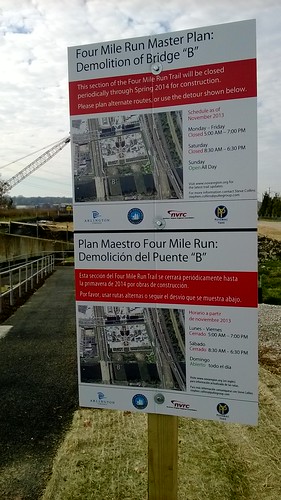
One of several signs announcing the detour
A detour was supposed to start on in my bicycle commute, but the demolition must be behind since it hasn't happened as of December 2nd (2013) per announcements.
Four Mile Run Potomac Yard Bridge Demolition Updates
As of today, this is what the text says:
Starting December 2nd and running for approximately 6 months, a short section of the Four Mile Run trail in Potomac Yard near the junction with the Mt. Vernon Trail will be closed during most commuting hours due to demolition of a bridge overhead.I have given it some thought, and for most people there aren't workable alternate routes that don't add significantly to the distance or that you use surface streets through Crystal City, which means that you ride on (ugh) surface streets. Well, whatever, as they say. It continues ~
A detour will be provided, but many riders may find it better to pick an alternate route to avoid the construction area altogether.
The detour - designed for ADA compliance, not necessarily bicycles - diverts traffic off of the trail onto the Jeff Davis Hwy west side sidewalk and also at the new switchback ramps to cross US1 at the S. Glebe Road signal. For those who are game, the switchback does incorporate a flight of stairs with bike rails built in.I find this part quite annoying. The "switchback ramps" are not "not necessarily [for] bicycles" but absolutely not for bicycles, if they mean while being ridden. And the "bike rails" are simply boards butted up against the railing, not trough-style rails that guide the bike properly up and down the stairs. Pitiful. "If you are game" - what's that about? It is either OK or it isn't OK. It isn't OK.

Above is a screen grab from a video from Arlington County that shows the switchbacks while under construction (although it is not, in fact, in Arlington County)

The stairs that is part of the detour, with the so-called "bike rails"

This image shows what a proper bike rail looks like
Wednesday, November 27, 2013
Get the Kids Riding

Happy rider - moving along steadily
This is from a few weekends ago - this young rider from the neighborhood is making his way up the trail alongside "Lucky Run." Apparently he enjoys having a distinctive bike. It isn't clear how much the "chopper" design changes the dynamics of how the bike rides - the combination of a very long wheelbase considering the low position of the rider and the small head angle and the amount of trail. (See this for some explanation of bicycle geometry.)
Observing him ride up the slight hill, my sense was that the bicycle frame design wasn't an issue so much as the single speed aspect - once the hill started getting even slightly (but not very) steep, he got off and walked. Fortunately it is mostly pretty flat around here . . .
Saturday, November 23, 2013
"Make Us Bicyclists Look Good"
Last Monday I took the day off - as the end of the "leave year" (accumulated vacation time) is approaching, I have more than I can "carry over" so I am having many three day weekends. The weather was slightly odd for November since it got up to 70 degrees (F - around 19-20 C). I did a counterclockwise circuit, riding north along the Potomac and then heading up near Rosslyn on a trail that runs along I-66. In Rosslyn while waiting at a light to cross, I looked down and found the stenciled message below.
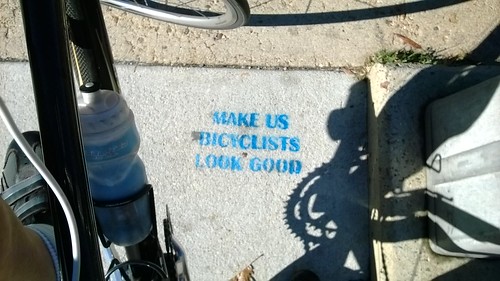
This means you!
This is an area that I am not crazy about riding in, but since it isn't a very long part of what is otherwise a ride I enjoy, no worries. The reason I don't like it is that after miles of riding on trails, here it is necessary to ride on the sidewalk - although there aren't many pedestrians. This location, where Lee Highway crosses Fort Myer Drive, feels like as a cyclist one is intruding on the automotive bliss (or hell) the the drivers are experiencing. Because of a curve in the road for the oncoming one way traffic, a person would be crazy to venture to cross three lanes of traffic that can come zipping out of D.C. So there is time to contemplate this statement painted on the sidewalk.
I have blogged about my views on the "cyclists should model model behavior" before. I don't care much for it as a priority - to summarize my thinking.
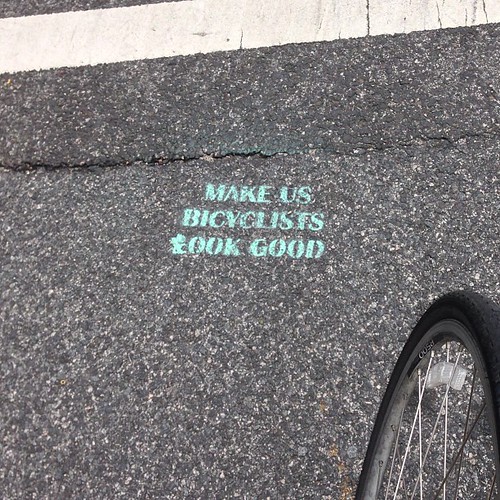
Another Flickr user in DC has a similar photo
To me, this statement - "make us bicyclists look good" - begs the question, look good to (or for?) who? (Or whom, I suppose.) And for what purpose? Make us bicyclists look good to the motorists so they will respect our law-abiding nature? (And not run us over.) Really? Keep in mind almost all of these same motorists are from time to time committing all sorts of small traffic infractions (exceeding posted speed limits, not making full stops at stop signs, talking on cell phones, texting, on and on).
The classic Disney cartoon portraying motorist behavior
This 1950 Disney cartoon, with Goofy portraying the crazed "Mr. Wheeler" when behind the wheel and the calm "Mr. Walker" while on foot, demonstrates the reality I see - most drivers, looking for an advantage in getting down the road more quickly themselves, aren't spending mental energy toting up a positive karma scores for cyclists when they see one who is 100 percent law abiding. If you get in their way, they'll remember that - not in a good way, of course - but if you stay out of their way, they are down the road. Bye!

This means you!
This is an area that I am not crazy about riding in, but since it isn't a very long part of what is otherwise a ride I enjoy, no worries. The reason I don't like it is that after miles of riding on trails, here it is necessary to ride on the sidewalk - although there aren't many pedestrians. This location, where Lee Highway crosses Fort Myer Drive, feels like as a cyclist one is intruding on the automotive bliss (or hell) the the drivers are experiencing. Because of a curve in the road for the oncoming one way traffic, a person would be crazy to venture to cross three lanes of traffic that can come zipping out of D.C. So there is time to contemplate this statement painted on the sidewalk.
I have blogged about my views on the "cyclists should model model behavior" before. I don't care much for it as a priority - to summarize my thinking.

Another Flickr user in DC has a similar photo
To me, this statement - "make us bicyclists look good" - begs the question, look good to (or for?) who? (Or whom, I suppose.) And for what purpose? Make us bicyclists look good to the motorists so they will respect our law-abiding nature? (And not run us over.) Really? Keep in mind almost all of these same motorists are from time to time committing all sorts of small traffic infractions (exceeding posted speed limits, not making full stops at stop signs, talking on cell phones, texting, on and on).
The classic Disney cartoon portraying motorist behavior
This 1950 Disney cartoon, with Goofy portraying the crazed "Mr. Wheeler" when behind the wheel and the calm "Mr. Walker" while on foot, demonstrates the reality I see - most drivers, looking for an advantage in getting down the road more quickly themselves, aren't spending mental energy toting up a positive karma scores for cyclists when they see one who is 100 percent law abiding. If you get in their way, they'll remember that - not in a good way, of course - but if you stay out of their way, they are down the road. Bye!
Tuesday, October 15, 2013
Positive Cycling Propaganda from Arlington Country (Virginia)
Typically the word "propaganda" is not given a positive spin - Wikipedia says, "While the term propaganda has acquired a strongly negative connotation by association with its most manipulative and jingoistic examples . . . propaganda in its original sense was neutral, and could refer to uses that were generally benign or innocuous . . . " and that "Propaganda is a form of communication aimed towards influencing the attitude of the community toward some cause or position by presenting only one side of an argument. Propaganda statements may be partly false and partly true. Propaganda is usually repeated and dispersed over a wide variety of media in order to create the chosen result in audience attitudes."
It seems pretty clear that Arlington County wants this new video it has produced to influence community attitudes towards cycling. Yes. The video is described here.
Overall the video is well done, although it is a little heavy on County employees (so called "County staff") as talking heads. In particular it would have been nice to have some graphics showing some of this growth in cycling they are talking about and perhaps a map. Also, as someone who lives in south Arlington I note that the outdoor shots are almost entirely from north Arlington (which is where the County admin types work and perhaps focus more of their attention?). One shot of south Arlington, along Four Mile Run (that is on my regular work commute by bike) at 4:58 through 5:05 and again 5:43 through 5:48 shows part of the trail that I know is in Alexandria, not Arlington, because of a recent question I sent to the Arlington bike coordinator about the zig-zag trail that is being installed there (and that is shown in the video). Oops.
Addendum 10/16 -- the mention of Crystal City and the video of streets scenes there, including aerial shots of Boeing's local HQ and the like is in south Arlington but I would suggest is quite different from the rest of it - also, it seems that Crystal City is mentioned since the big corporations gave $250,000 to start Capital Bikeshare there. (Which I didn't know. Interesting.) Anyway, the more I think it over, the more I am (slightly) annoyed that they couldn't do a little better to show more of the cycling infrastructure further than a few miles from their offices in north Arlington.
Addendum #2 10/16 -- at 8:30 the talking head person says that "the goal is [for Arlington] to become the best biking city on the east coast; the Country board set the goal for staff [i.e., the Country employees] . . . " - as a goal, I find this disappointing. Really, we are conceding leadership to Portland or Seattle or ??? What the heck. Why.
It seems pretty clear that Arlington County wants this new video it has produced to influence community attitudes towards cycling. Yes. The video is described here.
As Arlington's bicycle program, BikeArlington's mission is to get more Arlingtonians biking more often, whether they're commuting, shopping, or just having fun. We do this through encouragement as well as education, and what better way to educate our community on bicycling in Arlington than with a documentary on everything that we do to achieve that goal?
Overall the video is well done, although it is a little heavy on County employees (so called "County staff") as talking heads. In particular it would have been nice to have some graphics showing some of this growth in cycling they are talking about and perhaps a map. Also, as someone who lives in south Arlington I note that the outdoor shots are almost entirely from north Arlington (which is where the County admin types work and perhaps focus more of their attention?). One shot of south Arlington, along Four Mile Run (that is on my regular work commute by bike) at 4:58 through 5:05 and again 5:43 through 5:48 shows part of the trail that I know is in Alexandria, not Arlington, because of a recent question I sent to the Arlington bike coordinator about the zig-zag trail that is being installed there (and that is shown in the video). Oops.
Addendum 10/16 -- the mention of Crystal City and the video of streets scenes there, including aerial shots of Boeing's local HQ and the like is in south Arlington but I would suggest is quite different from the rest of it - also, it seems that Crystal City is mentioned since the big corporations gave $250,000 to start Capital Bikeshare there. (Which I didn't know. Interesting.) Anyway, the more I think it over, the more I am (slightly) annoyed that they couldn't do a little better to show more of the cycling infrastructure further than a few miles from their offices in north Arlington.
Addendum #2 10/16 -- at 8:30 the talking head person says that "the goal is [for Arlington] to become the best biking city on the east coast; the Country board set the goal for staff [i.e., the Country employees] . . . " - as a goal, I find this disappointing. Really, we are conceding leadership to Portland or Seattle or ??? What the heck. Why.
Saturday, June 1, 2013
Plywood Trail Replacement Wearing Out
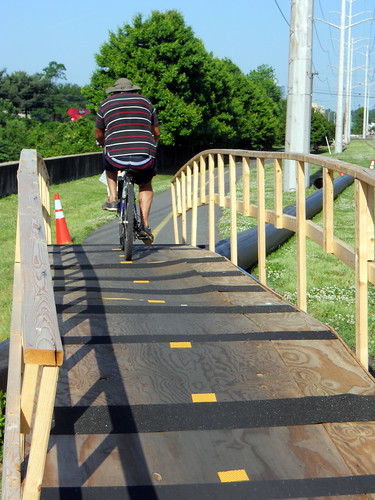
The problem as of June 1 2013 - 100s of pounds of cyclists pounding these plywood sheets, day after day
About 1 3/4 miles from my house, along Four Mile Run on the bike (or mixed use) trail, Arlington County installed a temporary (one hopes) bypass storm drain pipe across the trail during the first week of May (2013). They built a ramp (or bridge) over this so that the trail is still usable. It is built out of plywood and the construction techniques leave something to be desired now that it is clear that it is going to be up for longer than say a week. The construction, not great in the first place, is gradually failing. Lawsuit alert!
The original execution had plain sheets of unpainted or treated plywood such that when it rained they were a bit slick. It struck me as obvious that the boards should be painted or treated with something and at that time throw some sand into the mix to add some traction. So I contacted this County with this brilliant observation:
My comment, made May 8 2013
Subject : WEBSITE COMMENT: Temp bridge over pipe -- ATTN: trails
Comments : On the bike trail along s glebe rd about 1/4 mile s of I-395 there is a new temporary plywood ramp over a pipe. This ramp is getting tire residue and is plain wood. When wet it is slick for bicycles. Can't you paint it and throw some sand on the paint for safety?
Thank you.
The County is fairly responsive. I was slightly amused by the notion that "exterior surfaces are slippery when wet" as being something they couldn't address but whatever.
First reply, May 9 2013:
Michael,
Thank you for writing about the ramp on the Four Mile Run Trail at South Glebe Road. Most exterior surfaces will be slippery when wet, but I will forward your observation to the unit who is working with the contractor. They may have a surfacing material with more traction for the ramp.
I was surprised (and I suppose pleased) to get a follow-up message soon after.
Second reply, May 10 2013:
Good Morning Michael,
Again, thank you for notifying trails of the condition of the bike trail ramp during the rain. The contractor has placed non-skid mats on the ramp to increase friction when bikes ride over it. Please see the attached picture for your reference. If you have any additional concerns in regards to the temporary bike ramp on S Glebe Rd, please do not hesitate to contact me.
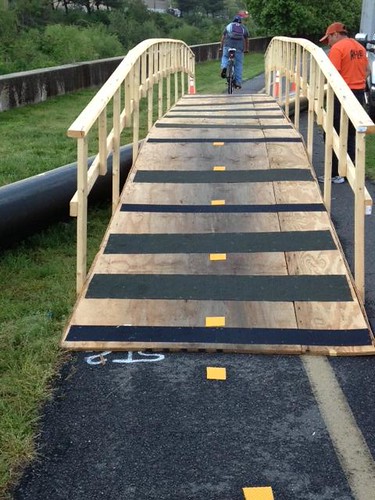
Photo sent me by County showing how they solved the problem of slickness during rain (as of May 10)
This is a case of what happens when one (in this case me) is not very clear. I don't really see how strips like this solve the overall problem since there is plenty of area that is not covered by the traction material. And it doesn't address what is turning out to be more of a problem, which is that the untreated/unpainted boards are suffering under a higher level of pounding/usage than the County or this contractor imagined. I would not have guessed that a temporary structure of this quality was intended to serve this long - and apparently longer. Who knows how long.
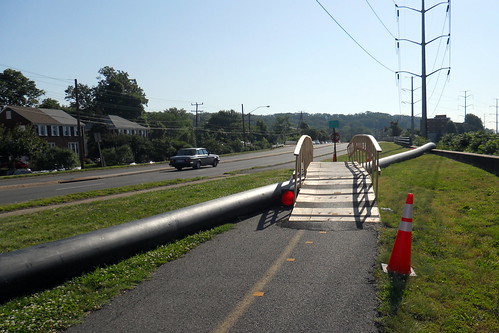
June 1 - looks OK at this distance, although one railing clearly bowing in

Closer examination reveals somewhat wavy deck
The contractor chose to run the plywood longwise but it wasn't wide enough to cover the entire deck, so they have two sheets of plywood, one larger and one smaller, running side by side. Amazingly dumb. It would have been much better to run the plywood sideways so there is no "seam" running the same direction as the direction of travel.
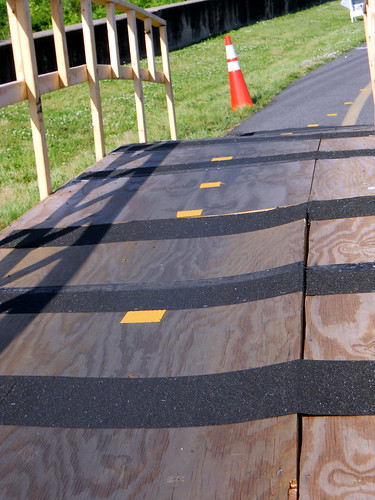
Looking in other direction, clear that main sheet of plywood coming up
In the first picture in this blog post, another problem is clear, if you think about it. Cyclists are mostly are not used to riding on ramps like this and it isn't that wide - so they pretty much want to be in the middle (notwithstanding the little yellow striping that suggests this is some sort of miniature divided highway). Because many cyclists are apparently not used to be presented with problems of this sort, they try to cross in both directions at the same time as other cyclists or as pedestrians even though common sense would suggest that it is a bit risky. The County supplied signage warns as you approach in one direction "bump" (???) and "slow" (that's OK, I guess) in the other.
I will send the County a link to this blog post and perhaps they will make it better.
Or not. We'll see. . . . .
Tuesday, May 21, 2013
"Jet Roars over Bicycle Path near Washington's Nation[al] Airport"
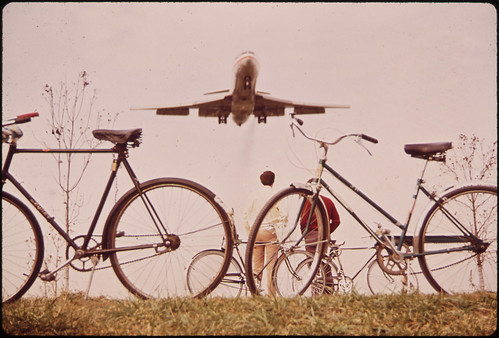
Jet Roars over Bicycle Path near Washington's Nation[al] Airport.
From the National Archives and Records Administration (NARA) "Commons" space on Flickr. Flickr redid their interface overnight and the opening screen features what they call "The Commons" more. I assume that rendering the name of the airport as "Nation Airport" rather than National Airport (now Reagan National Airport) is a typo. ??? It's also slightly odd that the subject heading is for Washington DC without one for Arlington VA. While it is nominally Washington's airport it isn't in Washington.
Original Caption: Jet Roars over Bicycle Path near Washington's Nation Airport. Noise-Decibel Level from Aircraft at This Altitude Can Cause Permanent Ear Damage. 11/1972
U.S. National Archives’ Local Identifier: 412-DA-2470
Photographer: Calonius, Erik
Subjects:
Washington (District of Columbia, United States) inhabited place
Environmental Protection Agency
Project DOCUMERICA
Persistent URL: arcweb.archives.gov/arc/action/ExternalIdSearch?id=544963
Access Restrictions: Unrestricted
Use Restrictions: Unrestricted
~~~~~~~~~~~~~~~~~~~~~~~~~~~~~~~~~~~~~~~
Now the noise level is much lower from jet engines than in 1972. The 727 was known for being particularly noisey. At least there is some progress. . . And one doesn't see 727s any more - not all gone I'm sure but not used here.
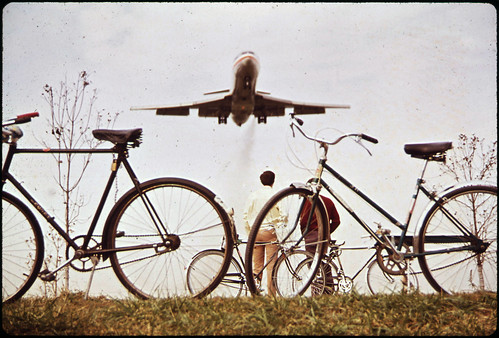
A color corrected version so the sky isn't such an odd color
Monday, September 3, 2012
Trail Safety Enhancements
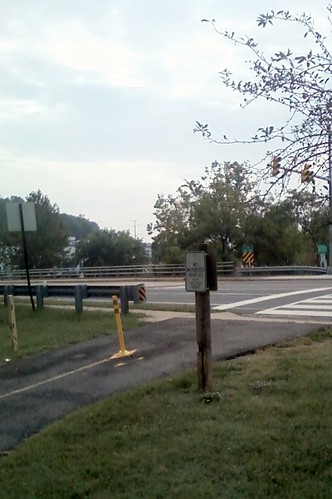
The newly configured transition from crosswalk to trail
As Mr. Lenin said, one step forward and two steps back. Or did he say two steps forward and one step back? I can't keep that straight.
This is at Walter Reed and Arlington Mill Road in Arlington (Virginia). The Country does occasional maintenance on the trails that sometimes is difficult to understand, although most of this effort seems OK.
Previously there were two steel bollard-type posts that sat in steel sleeves that were in the asphalt - the sleeves stuck out of the asphalt an inch or two and the steel post could be locked to the sleeve.

The previous hazard - helpfully marked by someone with yellow paint
A while ago one of the steel posts disappeared, leaving the sleeve as a hazard - you wouldn't want to ride your bike over this bit of metal poking out of the asphalt. Eventually someone (from the County? one assumes) came along and painted it yellow like this. It then stayed like this for a month or so.
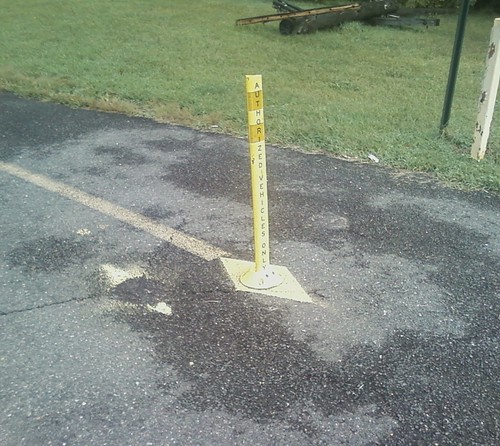
How long will this piece of plastic last?
Finally the County came along and removed the remaining steel post and both the sleeves and installed this plastic thing. I guess a bicycle is an "authorized vehicle" (ha ha). Typically these plastic bollards (if that is what one calls them) don't stay in place very long, but the mounting thing that would remain if the plastic strip disappears wouldn't be the same kind of hazard for cyclists as the previous steel sleeve - but still, it won't be something you want to run into directly since it could cause a rider to lose control.
Often these developments feel like an evolution of compromises . . .
Wednesday, August 15, 2012
"Nobby" Bicycle Suits (1896)
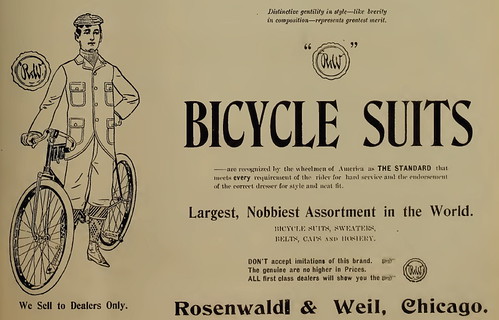
Cycling attire ad, 1896
From "The Referee and Cycle Trade Journal: a Weekly Record and Review of Cycling and the Cycle Trade." Volume 17, Number 1 - May 7, 1896.
archive.org/details/refereecycletra171896chic
Women cyclists of the 1890s often wore special clthing specifically created and intended for cycling, such as bloomers. I usually think of the tweedily attired male cyclists from the 1890s as riding in a version of their regular clothes, but this kind of ad suggests otherwise.
The slogan of this company, Rosenwald & Weil, seems a bit obscure - "Distinctive gentility in style - like brevity in composition - represents greatest merit."
Saturday, January 28, 2012
Flat Tire Blues?
Really, though, it wasn't so bad . . . or anyway it could have been worse.
Lately I have been commuting every day on my 30 year old Bridgestone. Two weeks ago, I got ready to go and when I put air in the rear tire, it started coming out faster than I could put it in! The edge of the hole in the wheel that the stem passes through had a rough edge that had made a hole in the rubber of the tire that extends a small way up the stem creating a leak. This was not a "puncture" flat of the usual sort but still, flat tires tend to come in "threes" so I guess I wasn't surprised when yesterday I had a flat tire on the way to work.
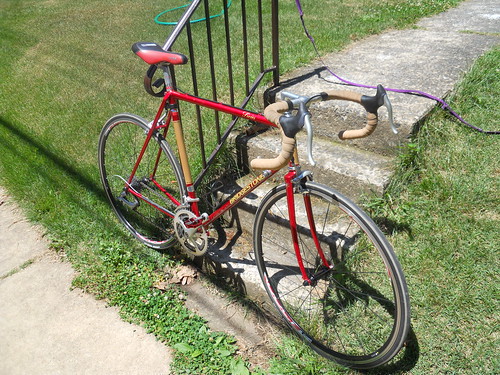
My nice 1982 Bridgestone Sirius, with air in the tires
Before 7 am these days, it is dark out. Plus the weather yesterday was strange - the temperature this early was close to 60 degrees - but rain was threatening so I was pretty sure that stopping to fix a tire was going to increase my chances of getting wet. As it turned out, I was just at where the Four Mile Run trail passes under Route 1 and the GW Parkway near the south end of the airport, so I pulled over between two lights and at least could see what I was doing.
I like to imagine I can fix a flat in ten minutes or less, but it is always more like 15. Off comes the tire and I pull out the tube and mark the tube with my Sharpie as to which side of the tube was which - if I don't do that, then when I find out where the hole is it is just that much more work figuring out if the sharp thing that came through the tire is still there or not. (I never like putting in a fresh tube not knowing what caused a whole in the previous one.) I put some air in the tube and easily found the hole, marked it, then matched it up with the tire and quickly found a very stiff bit of fine wire, say 3/8 inch long, going right through the tire that had punctured the tube. It was nice that there was no damage to the tire at least. Even with Kevlar belts this kind of thing is going to happen, although how this wire had been sitting there on the trail, standing on end waiting for a bike tire to poke into, is hard to imagine. Out comes the wire from the tire, take new tube from tool bag, put wheel back together, fill with air and off I go.

I guess I should have put on some rubber gloves
Nine riders went by while I worked on my tire - none of the fair weather bike commuters out on a day like this! I was a little disappointed that of the nine, five rode by in silence (like I wasn't there) and only four offered to help with the usual "got what you need?" or similar. Of course, to stop on a day like this would be to increase the chances of getting caught in the rain. Not that we are going to melt . . .
Having fixed my flat about three miles into my ten mile ride, I then took off - I found that the wind was from the south (which is unusual at this time of day) and I made good time, although I didn't make up for the 15 minute "break" in my ride! Still, it was exhilarating. As I crossed the 14th St Bridge, I could see rain off to the north, but I got to work without getting caught in the rain. On the way to my office, after parking my bike in the garage, I looked out a window and was surprised to see water sluicing down the windows from a downpour. I don't mind riding in the rain, but not so much downpours, so even with my stop I managed to avoid that. Good!
Almost immediately after broad adoption of pneumatic tires for bicycles in the late 1880s, people began trying to figure out a way to avoid flat tires and yet have the obvious benefits of that kind of tire (as compared to solid rubber or other sold tires).
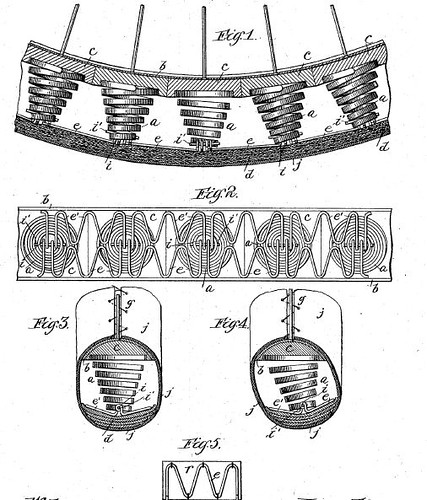
An example of an 1896 proposed alternative to the pneumatic tire
So far, however, nothing like to replace the pneumatic tire (and inevitable flat tires) has been developed that is widely used.
Lately I have been commuting every day on my 30 year old Bridgestone. Two weeks ago, I got ready to go and when I put air in the rear tire, it started coming out faster than I could put it in! The edge of the hole in the wheel that the stem passes through had a rough edge that had made a hole in the rubber of the tire that extends a small way up the stem creating a leak. This was not a "puncture" flat of the usual sort but still, flat tires tend to come in "threes" so I guess I wasn't surprised when yesterday I had a flat tire on the way to work.

My nice 1982 Bridgestone Sirius, with air in the tires
Before 7 am these days, it is dark out. Plus the weather yesterday was strange - the temperature this early was close to 60 degrees - but rain was threatening so I was pretty sure that stopping to fix a tire was going to increase my chances of getting wet. As it turned out, I was just at where the Four Mile Run trail passes under Route 1 and the GW Parkway near the south end of the airport, so I pulled over between two lights and at least could see what I was doing.
I like to imagine I can fix a flat in ten minutes or less, but it is always more like 15. Off comes the tire and I pull out the tube and mark the tube with my Sharpie as to which side of the tube was which - if I don't do that, then when I find out where the hole is it is just that much more work figuring out if the sharp thing that came through the tire is still there or not. (I never like putting in a fresh tube not knowing what caused a whole in the previous one.) I put some air in the tube and easily found the hole, marked it, then matched it up with the tire and quickly found a very stiff bit of fine wire, say 3/8 inch long, going right through the tire that had punctured the tube. It was nice that there was no damage to the tire at least. Even with Kevlar belts this kind of thing is going to happen, although how this wire had been sitting there on the trail, standing on end waiting for a bike tire to poke into, is hard to imagine. Out comes the wire from the tire, take new tube from tool bag, put wheel back together, fill with air and off I go.

I guess I should have put on some rubber gloves
Nine riders went by while I worked on my tire - none of the fair weather bike commuters out on a day like this! I was a little disappointed that of the nine, five rode by in silence (like I wasn't there) and only four offered to help with the usual "got what you need?" or similar. Of course, to stop on a day like this would be to increase the chances of getting caught in the rain. Not that we are going to melt . . .
Having fixed my flat about three miles into my ten mile ride, I then took off - I found that the wind was from the south (which is unusual at this time of day) and I made good time, although I didn't make up for the 15 minute "break" in my ride! Still, it was exhilarating. As I crossed the 14th St Bridge, I could see rain off to the north, but I got to work without getting caught in the rain. On the way to my office, after parking my bike in the garage, I looked out a window and was surprised to see water sluicing down the windows from a downpour. I don't mind riding in the rain, but not so much downpours, so even with my stop I managed to avoid that. Good!
Almost immediately after broad adoption of pneumatic tires for bicycles in the late 1880s, people began trying to figure out a way to avoid flat tires and yet have the obvious benefits of that kind of tire (as compared to solid rubber or other sold tires).

An example of an 1896 proposed alternative to the pneumatic tire
So far, however, nothing like to replace the pneumatic tire (and inevitable flat tires) has been developed that is widely used.
Wednesday, December 28, 2011
Arlington (VA) Survey of Area Cyclists
This short article summarizes a study of Arlington cyclists.
Here are the survey results. The survey results include information gathered in 2009 and 2011. Apparently they stopped riders on the trail to administer the survey.
The point of the survey, besides understanding who bikes in Arlington and why, was to assess the BikeArlington program.
Here are the survey results. The survey results include information gathered in 2009 and 2011. Apparently they stopped riders on the trail to administer the survey.
The point of the survey, besides understanding who bikes in Arlington and why, was to assess the BikeArlington program.
BikeArlington scored high satisfaction ratings in the survey. 79% of respondents reporting they were satisfied with the service, and more than half (54%) of BikeArlington users have already recommended the program to someone else. Most importantly, almost half of those who used BikeArlington services reported making a change in their biking behavior!!I confess I don't think of BikeArlington as a service and other than providing rider instruction and managing the bike trail system and bike lanes, I don't know what they do, in the sense of being able to "recommend the program to someone else." And making a "change in their biking behavior. . . ?" Hm.
Sunday, December 11, 2011
Why Cyclists May Avoid "Their" Bike Lanes
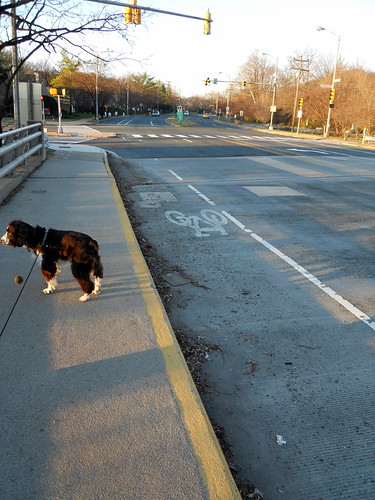
My dog isn't too interested, but the dedicated bike lane has some issues
A classic example of how the bike lane, created with much (ok, not much) fanfare when this bridge was resurfaced a few years ago, has become the place for little trashy crap kicked up by the passing cars - just the sort of thing to flat a bike tire. Mighty convenient for all of it to be stored right there in a special lane just for the bikes (and their tires)!

Close-up shows how much crap is in the bike lane
Sunday, October 30, 2011
Small Change Where 14th St Bridge Meets GW Trail
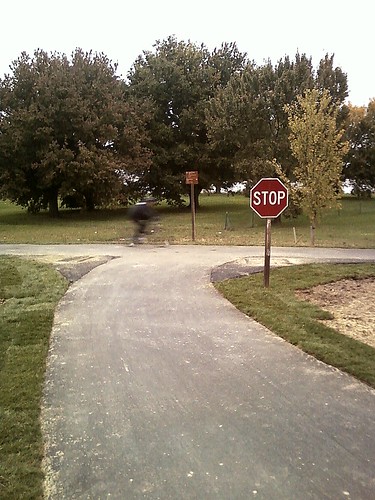
National Park Service had a bit of asphalt added to make this better
This is where the "off ramp" from the outbound 14th St Bridge trail/path meets the north-south GW Parkway trail. The NPS apparently realized that for cyclists the narrow "T" intersection was not working particularly well (which it wasn't) and added some asphalt to ease things.
By the way, in the above photo, it isn't that the cyclist (heading left-to-right) is incredibly fast so much as the camera is incredibly slow.
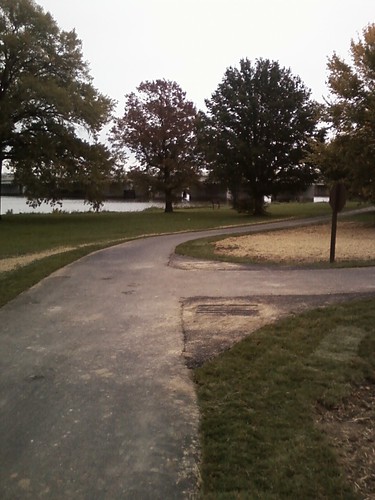
Looking south - extent of added asphalt more visible
It isn't clear if they are done adding turf or if there was some particular reason to add turf right next to the path, perhaps to make things safer/better for bikes that run off the trail?

I suppose they will put it back up, but I liked seeing the "dismount" sign this way
Sunday, October 16, 2011
Police Unity Tour on GW Trail
Sunday, mid-day - despite the excellent weather, not really that many riders out - any many were part of a local event supporting a national "Police Unity Tour" (by bike). The riders had event numbers on their clothes.

Came up upon this fellow heading north on the GW trail near National Airport
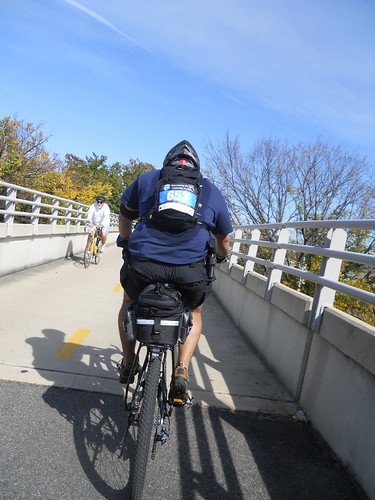
Riding with gun
I guess maybe this is a work-related activity? I don't see the need for this guy to be riding with his sidearm. I wasn't able to work out what jurisdiction he was from.

Came up upon this fellow heading north on the GW trail near National Airport

Riding with gun
I guess maybe this is a work-related activity? I don't see the need for this guy to be riding with his sidearm. I wasn't able to work out what jurisdiction he was from.
Friday, October 14, 2011
Four Mile Run Trail Flooding

Minor flooding of trail along Four Mile Run under Route 1
This is part of my morning commute - the heavy rain combined with the tides can lead to some flooding at this location, the low point of the trail along Four Mile Run. You can see that earlier the high point was perhaps 2-3 inches above where it is now. There was one time last winter after one of the heavy snows when there was a heavy rain storm that also melted snow and the flooding was probably a foot higher than this - I pulled myself along the fence to keep from peddling underwater. This was a dumb thing to do since bottom brackets are generally not watertight and enough grease was washed out that the bottom bracket started to emit rather amazing creaking noises. Always learning something . . .
Sunday, October 9, 2011
Overdue Bicycle Parked at Library Branch

Bicycle parked at Aurora Hills Branch Library, Arlington VA
You can't leave your bike locked up at one location for more than five days, or it gets removed. To where is a bit vague.
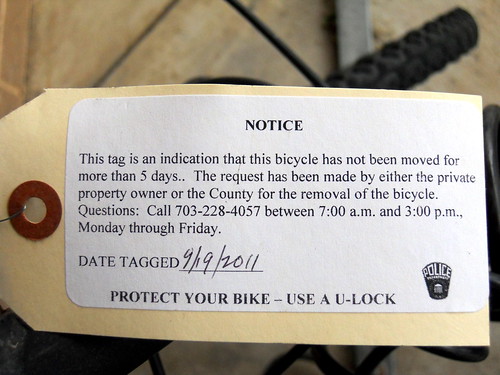
Tag on bicycle parked at Aurora Hills Branch Library, Arlington VA
I guess we won't have any books published like Bicycles Locked to Poles with its photos of bicycles in New York City (in various states of disassembly, mostly attached to poles with chains as heavy or heavier than the bikes themselves).
Subscribe to:
Posts (Atom)